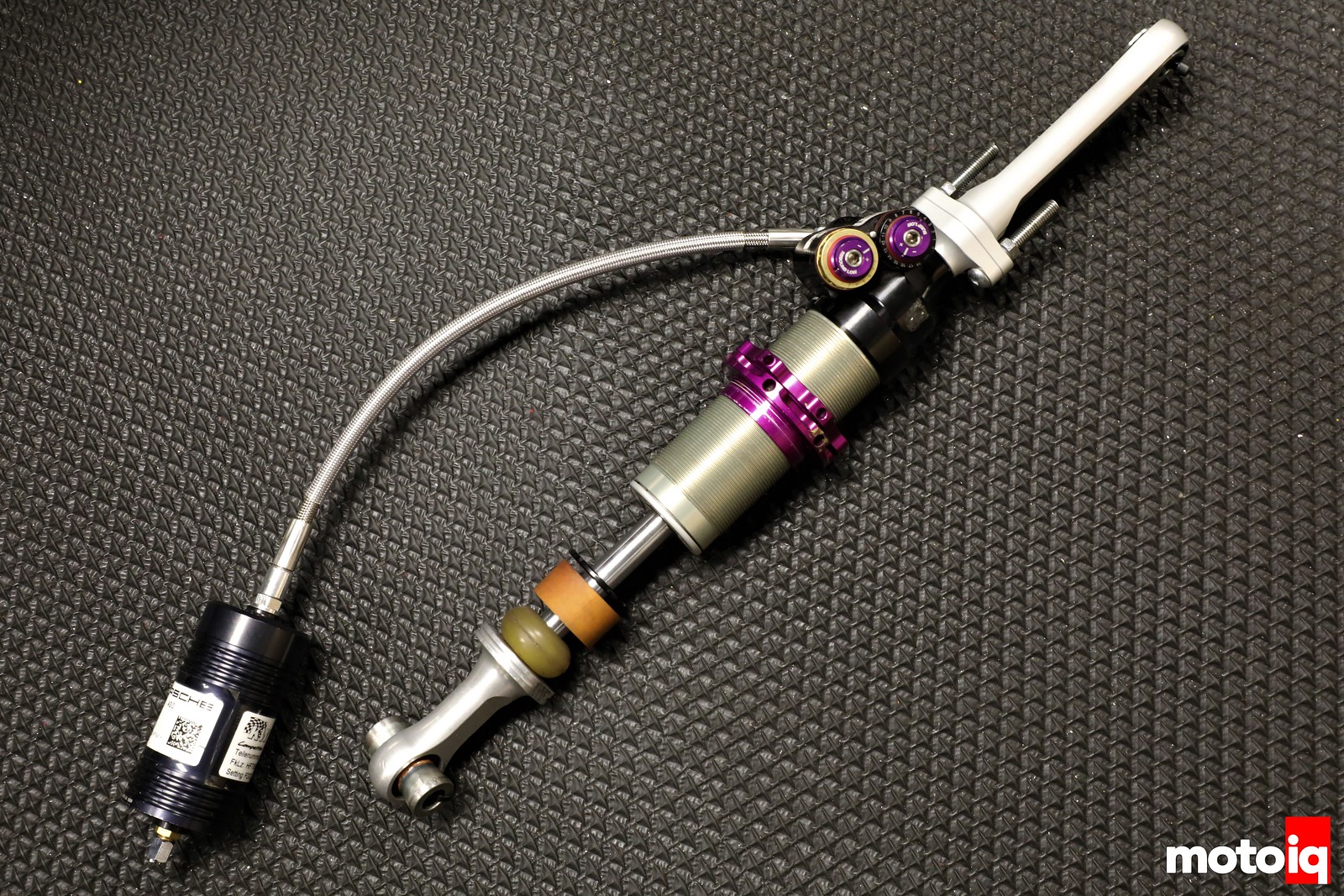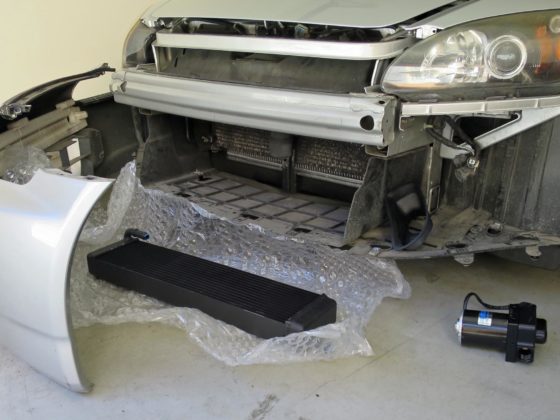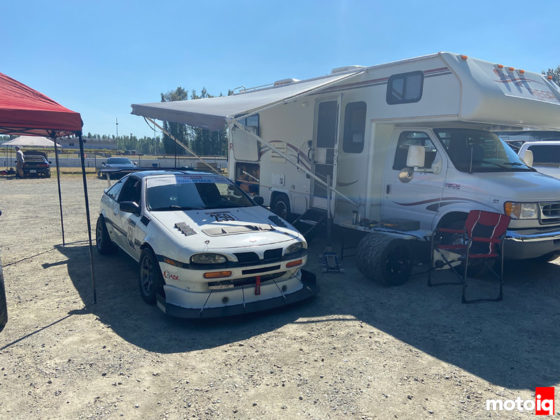
We were recently at KW Suspensions North American headquarters for some new product training and we got to take apart some of their latest technology, the innovative solid piston damper. The solid piston damper is a radical departure from conventional shock technology and is for sure worth a close look at how the insides work.
We had a quick look at the prototype solid piston damper at last years SEMA show. The concept was very fascinating to us and we were eager to see actual working shocks.

We got to see the insides of a 4-way adjustable solid piston shock from a Porsche 911 cup car. The shock is standard equipment on them. Here are the shocks guts minus the outer tube. Compared to other shocks, the solid piston is quite simple. That is one of the beautiful parts about it.

The solid piston shock is technically a twin tube. It has an inner and outer tube with the shock rod and piston contained in the inner tube. This is where the similarity to a conventional twin tube ends. In the KW solid piston shock the outer tube serves as a fluid transfer passage. The piston is connected to the shock rod. Unlike a conventional shock, the piston itself is solid with no valves! The piston serves to move fluid back and forth inside the shock and serves no function to control damping at all! Here is the shock rod, piston and inner tube, the outer tube has been removed.
On compression the piston moves the fluid and it flows through the black manifold pictured on the right. It then goes through a one way check valve and the compression valves. The fluid then flows out of the manifold and through the space between the inner and outer tube, through holes into the inner tube and to the other side of the piston. On rebound the fluid flows through the inner tube through the holes, through the space in between the inner and outer tube, then into the manifold through a one way check valve, then the rebound damping valves, then out the manifold and to the inner tube on the other side of the piston.
So the piston acts like a push me pull you for the fluid. This has many advantages. The first one is that there is a lot of fluid flow volume available to generate damping control force. Normally a lot of the compression damping is done by the small amount of fluid displaced by the shock shaft that flows out to the remote reservoir through the high and low speed compression valves. With this small volume of fluid generating the control force, the orifices must be very small and the valves tightly shimmed to develop hundreds or thousands of pounds of control force. This causes a big drop in pressure across the valve system. With the pressure drop you have the possibility of cavitation with localized boiling and aeration of the fluid. To combat this the shock must be pressurized to a high pressure which has issues with potential leaks, high seal sticksion and high gas reaction force which gives the suspension a potential rising rate.
With the solid piston shock the fluid volume of entire body of the shock is flowing through the valves giving the valves many times more fluid flow to develop the control force. With more fluid, the orifices and shims do not have to be as small or tightly preloaded to develop the force. More fluid flow, the more sensitive the valves are with less hysteresis. With greater fluid flow, the solid piston shocks run a lot cooler as well leading to more constant damping and more fade resistance.
With the solid piston doing the push me and pull you, there is very little pressure differential across the valves so there is less potential for cavitation! With less potential for cavitation the shock can run at a lower pressure. In fact, the remote reservoir can be a lot smaller because its only function now, is to hold enough gas to make up for the displacement for the shock shaft.




20 comments
looks similar to MCS shocks at 4x+ the cost
nvm, sounds different. feel free to delete. or leave up to show my ignorance…
It’s a good question! Motion Control shocks are completely different in operation and function. They have a neat turret type valve that makes the damping response to the adjuster click very consistent through the entire adjustment range. Moton was the first to have this type of valve and KW 3-Way club sports have something similar as well. However the way Motion Control shocks are and how the fluid flows is very conventional, not that there is anything wrong with that.
How does KW differentiate itself from Ohlins TTXs, Koni, or Penske through shaft shocks?
The KW solid piston shocks are not through shaft shocks. Not all TTX shocks are either, only the ILX series. The TTX is also a solid piston design but the valve design and function is very different. I think only one Penske shock is a thru shaft, the 8781 which is a cool twin piston design that I haven’t seen the insides of yet. The TTX has cartridge valves so revalving can be done very quickly, even while the shock is on the car which is a great feature while the KW has fast responding short travel valves which is an advantage. I don’t know much about Penske because they got me really mad a few years ago so I don’t support their company.
Dynamic does solid piston shocks “like” this too but they do their spool valves, of course. Koni 2822 Mk2 also but not sure what their shims look like. I remember seeing an interview with Quantum on why everyone moved to stuff like this and they commented that it’s the only practical way to do some of the adjustments.
Wow Koni came out with something new in 30 years! I think the applications are very limited to some or even one Formula car sizes. In fact I can’t even find them for sale! I think spool valves allow freer movement in high frequency square edged type bumps. The disadvantage is they have higher hysteresis. Working with spool valved shocks I like how they work. Not many people know but the older KW Motorsports valves are spool valves and have been for years before they became cool kid stuff. I hope to work on something with Dynamic shocks one day but they are not widely available here.
Dynamic seems very much to be a “call us and we’ll arrange a project consultation, oh and here’s the shipping address so we can put your car on the shaker rig” sort of deal – I know KW operates in that realm too, but it seems like Dynamic only operates in that realm these days. I’ve seen their modern stuff in SCCA paddocks on Atlantic cars here and there but not commonly on anything “lesser”. Can’t argue with some of the pro-level results though. Weirdly I think they used to do lower price point stuff too – I know a handful of guys who have them on E Production 1st gen RX-7s, though from the build sheets I think those are just conventional monotubes.
One of the things I think is interesting about KW as a company is that they don’t seem tied to just one way of doing things – their consumer stuff is modified classic twin tube, they do various motorsports monotubes with different adjuster concepts, and now these. Most other big shock makers seem to innovate within more limited areas if you get what I mean, and the smaller ones seem to innovate less but focus on tailoring to application.
There are interesting things in the KW Consumer twin tubes as well, they have something that works like a spool valve called a Phifer valve. They also have an internal offset adjuster so they can be blueprinted on the dyno. In fact all KW’s have that. I think before, Dynamic was a smaller boutique sort of damper maker and anyone could buy some made to order shocks. Then they were bought out by Multimatic and things are not so simple, sort of like Sachs. Interesting product, huge facilities but man how do you even go about buying them!
I love these kinds of articles. Thanks
Wow. This looks great. Simpler is always better. Would love to see these on a shock dyno compared to previous generations.
A lot of what makes these shocks different is not going to register on a dyno, its frequency dependent.
KW should have EMA dynamometers which would show the differences.
Also I know Penske might be sometimes difficult to work with but denying they are the most advanced shock manufacturer (along maybe with sachs) and also the most successful on most racing series worldwide is not giving credit where credit is due. KW might a huge application catalog but some of their shocks are just not very good (some are very good but the bulk sales is no different from a lot of other cheaper brands).
I don’t think an EMA dyno can hit the frequencies I am talking about. No doubt Penske is good and perhaps the absolute leader and innovator in damper technology. But I don’t need enerters or active suspension and my clients either race in classes where that technology isnt allowed or they cannot afford it. Penske made it clear to me that they are not interested in serving my customers market well with professional courtesy so I decided they don’t need my or my customers money. I was not impressed by my one user experience with Sachs. The shocks were somewhat crudely made, the adjustment knobs were confusing, every knob turned in a different direction to adjust. The detents were not clear to feel, I think as I recall the rebound didn’t have detents, it adjusted by fractions of a turn and worst of all the circuits seemed to have more bleedthrough than most good shocks. KW shocks are pretty decent quality, sometimes on their street shocks I don’t agree with the as supplied calibration but I send them in to get revalved and get different springs and no problem. It’s difficult to do street car calibration to satisfy all potential customers, KW does theirs on a totally stock car and builds a lot of adjustment for individual use into the valving. Tires and other suspension parts that a car might have made a huge difference on what is asked for from the shocks. KW uses a 7 post shaker rig (for a street car usually only 4 posts are used) and then does a lot of evaluation on rough and twisty German roads, high speed on the autobahn and on the Nurburgring and Hockenheim. Many times if I don’t like a calibration there was an engineering reason for it. Like some BMW’s use their engine as a mass damper and changing the spring rates to something I thought was good caused excitation on the shaker rig. Some Porsche cabriolets have a chassis stiffness issue so the same part number has to work on both models, etc. I think no other aftermarket performance shock company has as though validation as KW for street products. Don’t mix up calibration with quality. I have toured many companies and KW is the most impressive in engineering and validation thoroughness for there aftermarket performance parts. Sach and Ohlins were good as well but Sachs is almost completely Motorsports and Ohlins has limited applications off the shelf. I think MCS has a good product that is overlooked often as well. They are basically Motons, continued after they went out of business. Their marketing is not good but the product is.
I honestly believe that if all the shocks on the market were properly dynoed than some manufacturer like KW or Koni would reign supreme. Personally, working on my on MTB shocks, it’s all about assembly. I have rebuilt shocks that worked horribly as assembled, and have gotten great performance out of them, as long as I rebuilt them properly. Technology is one thing, but it never makes up for serviceability.
Idk if you are aware, but they DO have shock dynos with software that can evaluate frequency response.
“Road (random) – We can upload road profiles into our machine to simulate the roughness (or smoothness) of any road.
The video below shows our MTS 852 Damper Test System testing one of our custom-built dampers. It is tested with a sine profile of 5 inches at 1 HZ and 5 Hz, then a sine on sine profile with a major displacement of 5 inches at 1 Hz, minor displacement of 0.5 inches at 10 Hz (watch the video, it makes more sense!) then a major displacement of 5 inches at 1 Hz, and minor displacement of 0.5 inches at 20 Hz. ”
https://youtu.be/EmFseuQZ7sc
That’s an awesome shock dyno! None of the manufacturer’s I work with has one with that sort of capability. Roehrig seems to be the industry standard.
I know. Such data would be the Holy Grail. You just can’t expect it to be free.
After having dealt with MTS stuff at my last job I’ve been thinking of piecing together stuff for a dyno like that… biggest single problem is how to have enough power to drive the hydraulic pump. Used smallblock Chevy maybe. The cylinder’s pretty much just a cylinder with an LVDT, and if you know what you’re shopping for you can find used Moog valves on ebay for not horribly much.
If you look at the force and speed specs they give (24,500lb and 250 in/sec) and assume that it’s for the same cylinder, there’s about a thousand horsepower worth of hydraulic pump feeding that cylinder. I know that I don’t have 750kVa service in my home shop.
How about a small diesel?